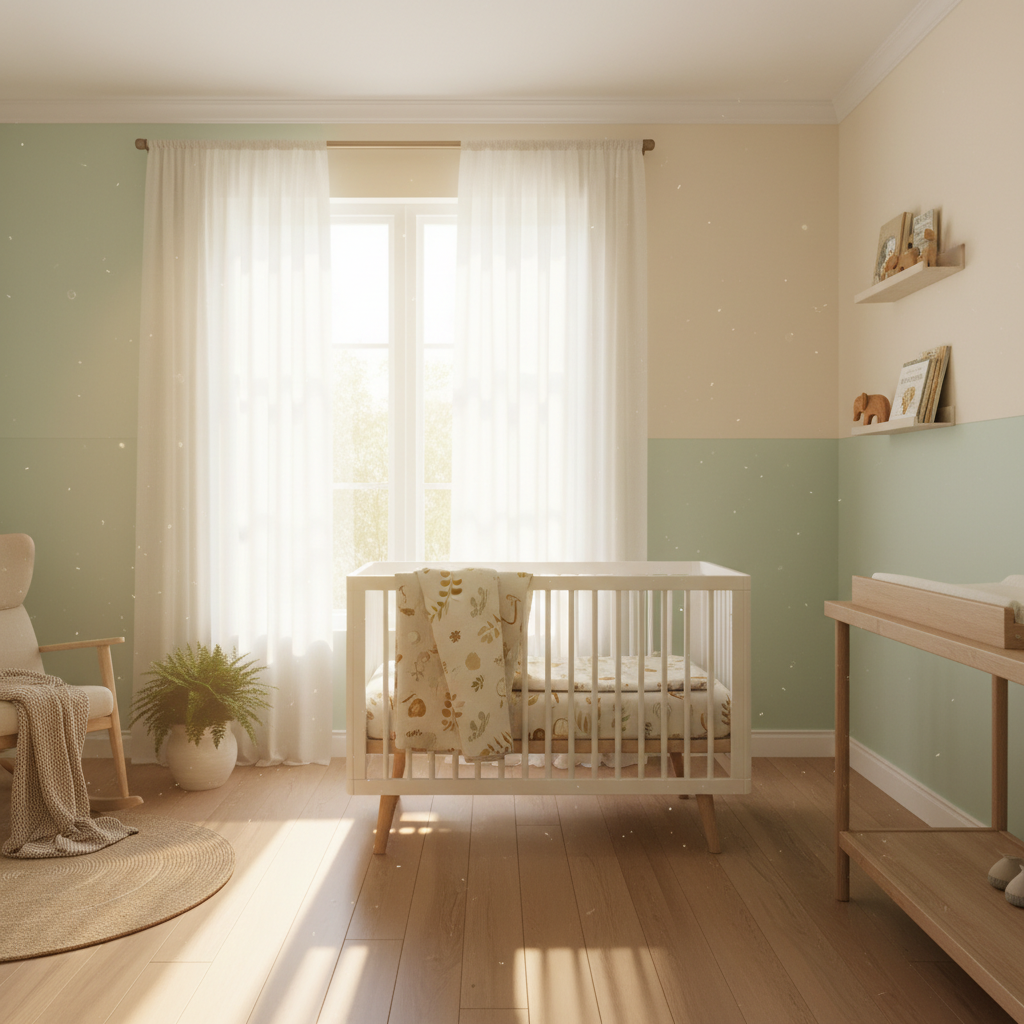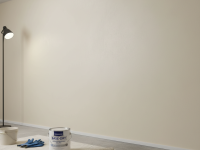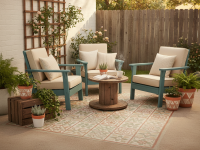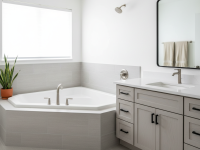Congratulations! You’re about to embark on one of the most exciting adventures: preparing a nursery for your little one. There’s nothing quite like dreaming up the perfect color scheme, arranging tiny furniture, and imagining your baby nestled safely in their new space. It’s a nesting instinct that brings so much joy!
But amidst the excitement, a nagging question often pops up for mindful parents like us: What about the paint? We’ve all been there, sniffing a freshly painted room and feeling that tell-tale “new paint” smell. While it might just seem like part of the process, that scent often signals the presence of Volatile Organic Compounds, or VOCs – and for a baby’s delicate developing system, these can be a real concern.
When we were getting our owursery ready, we realized how overwhelming the choices were. Every parent wants the safest, healthiest environment for their child, and for us, that started right with the walls. We dove deep into research, comparing brands, reading labels, and yes, even doing a few test patches. Our goal was simple: create a beautiful nursery that was also a haven of clean air.
That’s why we put together this guide – to share our journey and the non-toxic paint brands we’ve found and trust. We want to help you cut through the noise, understand what truly matters, and make informed choices so you can breathe easy knowing your baby’s room is as safe as it is beautiful.
Why Go Non-Toxic for Your Nursery? Understanding the “Why”
You might be wondering, “Is non-toxic paint really that important?” In short, yes, absolutely. Here’s why we prioritized it:
What are VOCs, Anyway?
VOCs are carbon-containing chemicals that turn into gasses at room temperature. They’re found in many household products, including traditional paints. When paint dries, these chemicals “off-gas” into the air, sometimes for months or even years. Common VOCs include formaldehyde, benzene, and toluene, to name a few.
Health Risks for Infants
Babies and young children are particularly vulnerable to VOCs because their respiratory systems are still developing, they breathe more rapidly than adults, and they spend a significant amount of time in their nursery. Exposure to VOCs can potentially contribute to:
- Respiratory irritation and issues like asthma and allergies.
- Headaches and dizziness.
- Nausea.
- Even more serious long-term health effects in extreme cases.
For us, the thought of our newborn inhaling these chemicals was enough to make us seek out safer alternatives. It wasn’t about being alarmist, but about being proactive and giving our baby the best possible start.
Peace of Mind
Ultimately, choosing non-toxic paint gave us immense peace of mind. Knowing that the air our baby was breathing in their most sacred space was as clean as possible allowed us to focus on the joy of parenthood, rather than worrying about invisible toxins.
Decoding Paint Labels: What to Look For
Navigating paint labels can feel like deciphering a secret code. Manufacturers throw around terms like “low-VOC” and “zero-VOC,” but what do they really mean? Here’s what we learned to look for:
“Zero-VOC” vs. “Low-VOC”: The Nuances
- Zero-VOC: This sounds perfect, right? However, regulations allow paints to be labeled “zero-VOC” if they contain less than 5 grams of VOCs per liter. While significantly better than traditional paints, it’s not always truly “zero.” Also, remember that the tinting process can add VOCs, so always check with the manufacturer or choose a brand that guarantees zero-VOC post-tinting.
- Low-VOC: This typically means less than 50 grams of VOCs per liter, which is an improvement over conventional paints but still higher than “zero-VOC” options. For a nursery, we always aimed for “zero-VOC” or as close to it as possible.
Third-Party Certifications
This is where things get really trustworthy. Look for certifications from independent organizations. The most prominent one we found and highly recommend is GREENGUARD Gold Certification. This certification means the product has been tested for over 10,000 chemicals and meets strict chemical emissions limits, ensuring it contributes to healthier indoor air quality. It’s like a seal of approval from scientists, not just the marketing department.
Ingredients to Avoid
Beyond VOCs, some other common paint ingredients you might want to steer clear of include:
- Formaldehyde: A known carcinogen.
- Heavy metals: Such as lead and cadmium (though lead paint is largely baed in modern manufacturing, it’s always good to be aware).
- Phthalates: Often found in plastics and some paints, linked to endocrine disruption.
- Amonia and APEs (Alkylphenol Ethoxylates): Can be respiratory irritants.
Our Top Non-Toxic Paint Brand Recommendations (Based on Our Experience!)
After much research and some hands-on testing, here are the brands that truly stood out to us for their commitment to health, performance, and overall quality. These are the ones we’d recommend to our closest friends and family.
1. Clare Paint: Design-Forward and Truly Zero-VOC
When we were looking for a modern, aesthetically pleasing option that didn’t compromise on safety, Clare immediately caught our eye. What impressed us about Clare is their commitment to making paint shopping easy and their truly zero-VOC formula. They formulate their paints to be Zero VOCs + Zero HAPs (Hazardous Air Pollutants) and are GREENGUARD Gold certified, which checked all our boxes.
Our Experience: We absolutely loved their curated color palette. It took the guesswork out of choosing from a million shades of white. The application was smooth, and the coverage was excellent, meaning fewer coats and less time painting. And the best part? Almost no paint smell, even right after painting. This was a huge relief, especially when trying to get the nursery ready a few weeks before the baby arrived.
2. ECOS Paints: The Gold Standard for Transparency
If you’re looking for ultimate transparency and a truly comprehensive range of non-toxic products, ECOS Paints is a fantastic choice. They are known for their incredibly low to zero VOCs (often lab-tested at undetectable levels) and are VOC-free even after tinting. They provide detailed ingredient lists and are also GREENGUARD Gold certified.
Our Experience: ECOS Paints felt like the most “purist” option. Their paints covered beautifully, and we were particularly impressed by the depth of color they offered. We used their air-purifying paint in a part of our home and noticed a definite improvement in overall air quality, which gave us even more confidence for the nursery. Their customer service was also incredibly helpful in answering all our detailed questions about ingredients and application.
3. AFM Safecoat: Hypoallergenic and Performance-Driven
AFM Safecoat has been a pioneer in the non-toxic paint industry for decades, specifically formulating products for individuals with chemical sensitivities and allergies. Their paints are incredibly low in VOCs, free of harsh chemicals, and designed for optimal indoor air quality. They focus on minimizing all forms of toxins, not just VOCs.
Our Experience: While perhaps not as widely known for trendy colors as some newer brands, AFM Safecoat is renowned for its consistent performance and dedication to health. We found their paints to be durable and to provide excellent coverage. If you or your family members have specific sensitivities or allergies, AFM Safecoat offers an unparalleled level of reassurance and has proven itself time and again in creating truly hypoallergenic spaces.
4. Benjamin Moore Natura / Aura (Low-VOC Options)
For those who prefer a more widely available brand with a trusted reputation, Benjamin Moore offers excellent low-VOC options. Their Natura line (though sometimes harder to find now) was specifically designed as zero-VOC, and their Aura line boasts very low VOCs and exceptional durability and color depth.
Our Experience: We’ve used Benjamin Moore paints in other areas of our home and always appreciated their quality. While not strictly “zero-VOC” across the board like ECOS or Clare (especially depending on the base and tint), their commitment to healthier formulations in lines like Aura means you’re getting a significant step up from conventional paints. Always ask your local retailer about the specific VOC content of the base and the tints, as this can vary.
Tips for Painting Your Nursery Safely
Even with the best non-toxic paints, a few extra precautions go a long way:
- Ventilate, Ventilate, Ventilate: Keep windows open and use fans during and after painting, even with zero-VOC paints. Fresh air is always your best friend.
- Paint Well in Advance: Aim to finish painting the nursery at least 4-6 weeks before your baby’s due date. This gives ample time for any residual off-gassing (even minimal from non-toxic paints) to dissipate completely.
- Use Low-VOC Primer: Don’t forget your primer! Many non-toxic paint brands also offer corresponding low or zero-VOC primers. Using a conventional primer negates much of the benefit of using non-toxic topcoats.
- Proper Prep and Cleanup: Use drop cloths to protect floors and furniture. Clean brushes and rollers with soap and water, and dispose of any leftover paint responsibly.
- Consider Natural Painting Tools: While less common, you can even find painting tools (brushes, rollers) made with natural fibers and without synthetic chemicals, if you want to go the extra mile.
Beyond the Walls: Other Considerations for a Healthy Nursery
Creating a healthy nursery is a holistic effort. While paint is a huge step, remember to also consider:
- Furniture Finishes: Look for cribs, dressers, and changing tables made from solid wood with non-toxic, low-VOC finishes or no finish at all.
- Flooring: Opt for natural materials like solid wood, wool carpets (certified low-VOC), or natural linoleum instead of synthetic carpets that can off-gas.
- Textiles: Choose organic cotton sheets, blankets, and curtains to avoid pesticides and chemical dyes.
- Air Purifiers: A high-quality air purifier with a HEPA filter can provide an extra layer of protection, especially in urban environments.
Conclusion
Preparing a nursery is an act of love, and ensuring it’s a safe, healthy space for your little one is one of the most important things you can do. Our journey into the world of non-toxic paints taught us that it’s entirely possible to create a beautiful, vibrant nursery without compromising on your baby’s well-being.
It might take a little extra research and perhaps a slightly higher initial investment, but the peace of mind knowing your baby is breathing clean air in their most intimate space is truly priceless. We hope our experiences and recommendations help you navigate your owursery renovation with confidence and joy. Happy painting, and congratulations again on your growing family!




